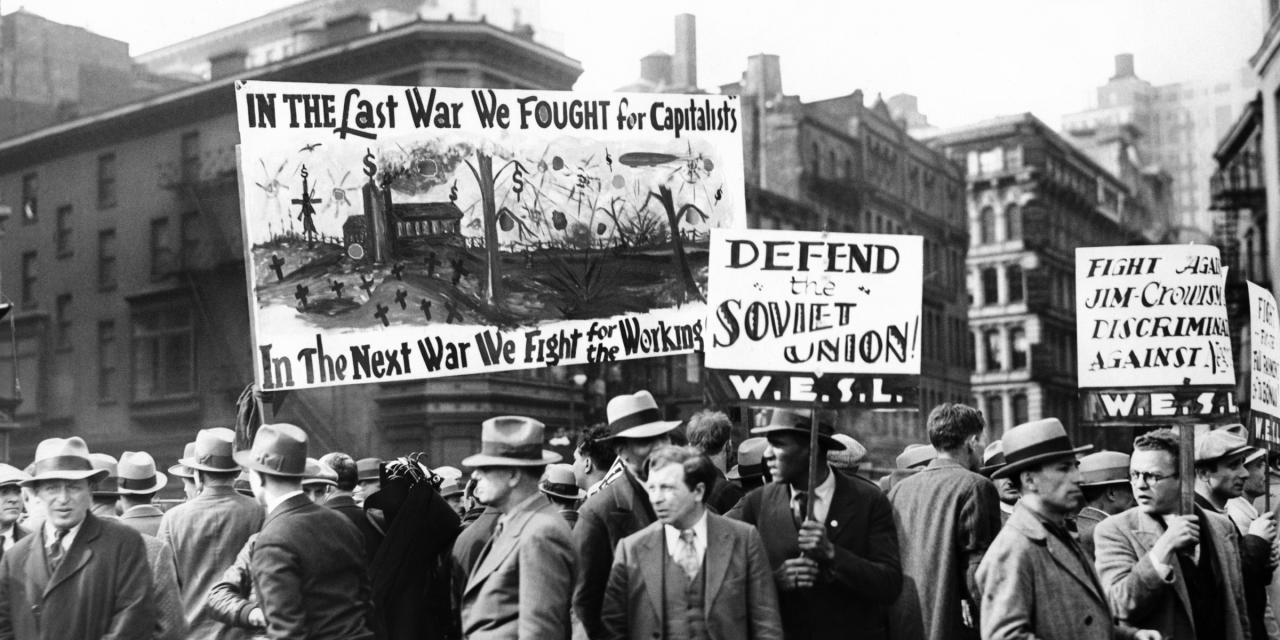
Communism: Uncovering Its Influence in Americas Institutions
Communism uncovering its influence in americas institutions – Communism: Uncovering Its Influence in America’s Institutions, a topic often shrouded in controversy and misunderstanding, deserves a deeper exploration. While the term “communism” evokes strong reactions, it’s essential to understand its historical roots, evolution, and the nuanced ways it has shaped American institutions.
This journey delves into the spread of communist ideas from their origins to their impact on American labor movements, social justice movements, and political discourse. We’ll explore the intricate tapestry of communist influence, examining its cultural, social, political, and economic effects on the American landscape.
From the rise of labor unions to the Civil Rights Movement, communist ideas have undeniably played a role in shaping American society. This exploration will shed light on the complexities of communist influence, acknowledging both its positive and negative contributions to the American narrative.
Historical Context

The origins of communist ideology can be traced back to the 19th century, rooted in the social and economic inequalities that characterized industrializing Europe. The core principles of communism were articulated by Karl Marx and Friedrich Engels, who argued for a classless society where the means of production are owned collectively, rather than by private individuals.The spread of communist ideas to the Americas was a complex process, influenced by a variety of factors, including the rise of labor movements, the influence of socialist thinkers, and the experiences of European immigrants.
The Spread of Communism in the Americas
The early 20th century witnessed a surge in communist movements across the Americas, driven by the social and economic upheavals of the period. The Russian Revolution of 1917 served as a powerful catalyst, inspiring revolutionary movements in various parts of the world, including the Americas.
- Latin America:The Mexican Revolution (1910-1920) saw the emergence of socialist and communist ideas, with figures like Emiliano Zapata and Pancho Villa advocating for land redistribution and worker rights. The Cuban Revolution (1953-1959), led by Fidel Castro, was also heavily influenced by communist ideology, resulting in the establishment of a socialist state.
- North America:The United States experienced a significant communist movement in the 1930s, fueled by the Great Depression and the rise of labor unions. The Communist Party of the United States of America (CPUSA) was formed in 1919, advocating for workers’ rights and social justice.
However, the CPUSA faced intense persecution during the Cold War, with its members facing blacklisting and imprisonment.
Different Communist Movements in the Americas
Communist movements in the Americas have exhibited diverse characteristics and goals, reflecting the specific historical and social contexts in which they emerged.
- Revolutionary Communism:This approach, exemplified by the Cuban Revolution, aimed to overthrow existing capitalist systems through armed struggle and establish socialist states.
- Reformist Communism:This approach, often seen in North America, focused on achieving social change through legal and democratic means, advocating for worker rights and social welfare programs within existing capitalist systems.
Influence on American Institutions
While the communist movement in the United States has never achieved the level of political power seen in other countries, its ideas have nonetheless had a significant and enduring influence on American institutions and society. This influence has manifested in various forms, from shaping labor movements and social justice activism to impacting political discourse and the structure of certain institutions.
Influence on Labor Movements
Communist ideas played a crucial role in the development of American labor movements, particularly during the early 20th century. The Industrial Workers of the World (IWW), a radical labor union founded in 1905, embraced many communist principles, including the concept of class struggle and the need for workers to unite in solidarity against capitalist exploitation.
The IWW advocated for a revolutionary overthrow of the capitalist system and the establishment of a socialist society. While the IWW’s influence waned over time, its legacy continues to be felt in the American labor movement. Many of the core principles championed by the IWW, such as the right to organize, collective bargaining, and workers’ rights, have become enshrined in American labor law and are now widely accepted as fundamental principles of a fair and just workplace.
Influence on Social Justice Movements
Communist ideas have also been influential in shaping various social justice movements in the United States. The Civil Rights Movement, for example, drew inspiration from communist ideals of equality and social justice. Many prominent civil rights activists, such as Martin Luther King Jr., were influenced by communist thinkers and their emphasis on nonviolent resistance and the pursuit of economic and social equality.The Black Power Movement, which emerged in the 1960s, also drew on communist ideas.
Black Power activists, such as Malcolm X and Stokely Carmichael, advocated for black self-determination and the creation of a separate black nation within the United States. While their ideas were often seen as radical and even threatening by the mainstream, they helped to raise awareness of the systemic racism and inequality faced by African Americans in the United States.
Influence on Political Discourse
Communist ideas have also had a significant impact on American political discourse. The Cold War, which pitted the United States against the Soviet Union, fueled a period of intense political and ideological debate in America. This debate centered on the merits of capitalism versus communism, with each side seeking to discredit the other’s ideology.The Cold War also led to a heightened awareness of the potential dangers of communist subversion and infiltration of American institutions.
This fear, often fueled by McCarthyism and other anti-communist campaigns, resulted in a crackdown on left-wing activists and organizations.
Influence on Education
Communist ideas have also influenced American education, although their impact has been more subtle and contested. During the Cold War, there was a widespread fear of communist indoctrination in schools, leading to the implementation of loyalty oaths for teachers and the removal of books and materials deemed to be communist propaganda.However, communist ideas have also influenced educational reform movements in the United States.
It’s unsettling to see the creeping influence of communist ideology within our American institutions. We need to be vigilant, understanding that our freedoms are under threat. Building a better future, prioritizing America’s prosperity, as outlined in this article , requires a clear-eyed approach to combatting these insidious forces.
We must ensure that our institutions remain true to the principles of individual liberty and free enterprise, not succumb to the collectivist ideals of communism.
The progressive education movement of the early 20th century, which emphasized student-centered learning and social justice, drew inspiration from communist ideas about the importance of education for social change.
Influence on Media
Communist ideas have also had a significant impact on American media, particularly during the Cold War. The media played a key role in shaping public opinion about communism and the Soviet Union. This often involved portraying communism as a threat to American democracy and freedom.However, there have also been instances where the media has provided a platform for communist ideas.
During the 1930s, for example, some newspapers and magazines were sympathetic to the communist cause and published articles and editorials that supported communist ideas.
Influence on Government
Communist ideas have also influenced American government, albeit in a more indirect way. The Cold War led to the expansion of the government’s power and the creation of new agencies, such as the Central Intelligence Agency (CIA), to combat the perceived threat of communism.However, communist ideas have also influenced the development of certain social welfare programs in the United States.
The New Deal programs of the 1930s, for example, which were designed to address the Great Depression, drew inspiration from socialist ideas about the government’s role in providing social safety nets for its citizens.
The insidious creep of communist ideology into America’s institutions is a disturbing trend, especially as it intersects with the evolving landscape of digital marketing. The ability to reach consumers effectively is crucial, but doing so in the age of privacy requires a shift in strategy.
This article offers valuable insights into navigating this new terrain, but the fundamental challenge remains: how can we effectively communicate in a world where privacy is paramount, while also combating the subtle influences of communist ideology that seek to undermine our values?
Cultural and Social Impact
The influence of communist ideas on American culture and society has been both subtle and profound, shaping artistic expression, social values, and national identity. While communist ideology has never gained widespread acceptance in the United States, its critiques of capitalism and social inequality have resonated with certain segments of the population, particularly during periods of economic hardship and social unrest.
Impact on American Literature
Communist ideas have influenced American literature through various themes and narratives. Authors like Jack London, Upton Sinclair, and John Steinbeck explored themes of social injustice, economic exploitation, and the struggles of the working class, drawing inspiration from socialist and communist ideals.
- Jack London’s “The Iron Heel” (1908): This novel depicts a dystopian future where a fascist regime, inspired by communist ideas, crushes individual liberties and imposes a totalitarian state.
- Upton Sinclair’s “The Jungle” (1906): This exposé of the meatpacking industry in Chicago highlights the exploitation of workers and the corrupting influence of capitalism.
- John Steinbeck’s “The Grapes of Wrath” (1939): This novel tells the story of the Joad family, who are forced to migrate from Oklahoma to California during the Dust Bowl era, depicting the harsh realities of poverty, unemployment, and social injustice.
These works contributed to a broader cultural conversation about social inequality and the need for social change, even if they did not explicitly endorse communist ideology.
Political and Economic Influence
The influence of communist ideas on American political and economic spheres has been a subject of intense debate and scrutiny. While the United States has never embraced a communist system of government, the principles of social justice, economic equality, and worker rights championed by communist thinkers have resonated with certain segments of American society, shaping political movements and influencing economic policies.
Influence on American Political Parties and Movements
The impact of communist ideas on American political parties and movements is multifaceted. While the Communist Party USA (CPUSA) has historically been a marginal force in American politics, its influence has been felt in various ways.
- Labor Movements:Communist ideas, particularly those emphasizing worker solidarity and collective bargaining, played a significant role in the rise of American labor unions during the early 20th century. The Industrial Workers of the World (IWW), a radical labor organization, drew inspiration from communist principles, advocating for worker ownership and control of industries.
- Progressive Era Reforms:The Progressive Era (1890-1920) witnessed a surge in social and political reforms, some of which were influenced by communist ideas. Progressive reformers, like the muckrakers who exposed corporate abuses and advocated for social justice, shared some common ground with communist thinkers.
- Civil Rights Movement:The Civil Rights Movement of the mid-20th century was a powerful force for social change, and some of its leaders, such as Martin Luther King Jr., drew inspiration from communist ideals of equality and social justice. King’s belief in nonviolent resistance was influenced by Mahatma Gandhi, who himself was inspired by the principles of non-violent civil disobedience advocated by Leo Tolstoy, a prominent Russian writer and pacifist.
It’s unsettling to see the insidious influence of communist ideology creeping into our institutions, and the recent events surrounding the millions heading to the polls for Super Tuesday only amplify these concerns. The very foundation of our democracy is being threatened by these subversive forces, and it’s crucial for us to remain vigilant and resist this insidious tide.
Impact on American Economic Policies and Practices
Communist ideology has had a significant impact on American economic policies and practices, particularly in shaping debates about economic inequality, worker rights, and government intervention in the economy.
- Social Welfare Programs:The New Deal programs implemented during the Great Depression, such as Social Security and unemployment insurance, were influenced by the ideas of social justice and economic security that were prevalent in communist circles. While these programs were not explicitly communist, they reflected a broader shift in American thinking about the role of government in addressing social and economic problems.
- Labor Laws:The Fair Labor Standards Act of 1938, which established minimum wage and overtime pay, was a major legislative victory for labor unions and was influenced by communist ideas about worker rights and fair treatment.
- Economic Regulation:The growth of government regulation in the American economy, particularly during the 20th century, can be partly attributed to the influence of communist ideas about the need for government intervention to address market failures and protect workers.
Debate Surrounding Influence on American Foreign Policy and International Relations
The influence of communist ideas on American foreign policy and international relations has been a subject of intense debate and controversy.
- Containment Policy:The Cold War era was characterized by a fierce ideological struggle between the United States and the Soviet Union. The American policy of containment, aimed at preventing the spread of communism, was a direct response to the perceived threat of communist expansion.
- Intervention in Developing Nations:The United States intervened in various developing nations, often citing the threat of communist influence. The US supported authoritarian regimes and military coups in countries like Guatemala, Iran, and Chile, aiming to prevent the rise of communist movements.
- Vietnam War:The Vietnam War was a major conflict in which the United States engaged to prevent the spread of communism in Southeast Asia. The war was highly controversial, with many Americans questioning the justification for US involvement and the effectiveness of the containment policy.
Contemporary Debates

The legacy of communist ideas in the Americas continues to spark debate and controversy, reflecting the enduring influence of these ideologies on the region’s political, social, and economic landscape. While some argue that communism has largely faded from relevance, others maintain that its principles remain relevant in contemporary discussions about social justice, economic inequality, and political power.
The Persistence of Communist Ideas
The ongoing debates surrounding communism in the Americas highlight the complex and multifaceted nature of its legacy. While many associate communism with the Cold War and the Soviet Union, its influence extends beyond these historical markers. The enduring appeal of communist ideas, particularly in Latin America, stems from their perceived ability to address issues such as poverty, inequality, and social injustice.
- Socialist Movements:In recent years, socialist movements have gained traction across Latin America, advocating for greater government intervention in the economy and social welfare programs. These movements often draw inspiration from the principles of communist thought, particularly in their emphasis on economic equality and social justice.
- Anti-Imperialism:Communist ideas have also played a role in shaping anti-imperialist movements in the Americas. The struggle against foreign intervention and the pursuit of economic independence have been key themes in communist discourse, resonating with populations that have experienced historical exploitation and unequal power dynamics.
- Indigenous Rights:Communist ideas have also been adopted by indigenous communities in the Americas who seek to reclaim their land, culture, and self-determination. These groups often find common ground with communist principles that emphasize collective ownership, social justice, and the fight against oppression.
The Legacy of Communism in the Americas, Communism uncovering its influence in americas institutions
Different perspectives exist on the legacy of communism in the Americas. Some argue that communist regimes in countries like Cuba and Nicaragua have failed to deliver on their promises of economic prosperity and social equality. Others maintain that the legacy of communism should be viewed in a more nuanced light, recognizing its contributions to social welfare, education, and healthcare in some contexts.
- Economic Performance:While some communist-led countries have experienced periods of economic growth, critics point to the limitations of centrally planned economies and the potential for corruption and inefficiency. They argue that communist systems often stifle individual initiative and innovation, leading to economic stagnation.
- Social Progress:Supporters of communist regimes highlight their achievements in reducing poverty, improving access to healthcare and education, and promoting social justice. They argue that communist principles have provided a framework for addressing historical inequalities and fostering a more equitable society.
- Political Freedom:Critics of communism often point to the suppression of political dissent and the lack of individual freedoms under communist regimes. They argue that communist systems often prioritize state control over individual rights and freedoms, leading to authoritarianism and the suppression of political opposition.
Future Influence of Communist Ideas
The potential for future influence of communist ideas in the Americas is a topic of ongoing debate. While some argue that the global decline of communist regimes and the rise of market-oriented economies have diminished the relevance of communist ideas, others believe that these ideologies remain relevant in the face of growing economic inequality, social injustice, and political polarization.
- Economic Inequality:The widening gap between the rich and the poor in many countries, coupled with the perceived failures of neoliberal economic policies, has fueled renewed interest in socialist and communist ideas. The argument for greater government intervention in the economy and the redistribution of wealth has gained traction in recent years.
- Social Justice Movements:The rise of social justice movements, such as Black Lives Matter and Me Too, has brought attention to issues of racial inequality, gender discrimination, and systemic oppression. These movements often draw inspiration from communist principles that emphasize solidarity, collective action, and the fight against injustice.
- Political Polarization:The increasing polarization of political discourse and the rise of populist movements have created fertile ground for the spread of radical ideologies, including communism. The perceived failures of traditional political institutions and the growing distrust in established power structures have led some to seek alternative solutions, including those offered by communist ideology.
Final Wrap-Up: Communism Uncovering Its Influence In Americas Institutions

The influence of communist ideas on American institutions is a complex and multifaceted topic. It’s crucial to recognize that communism is not a monolithic ideology, and its impact has varied across different historical periods and social contexts. By understanding the nuances of this influence, we can gain a more comprehensive and informed perspective on American history and its ongoing evolution.
While the debate surrounding communism’s legacy continues, this exploration offers a glimpse into its profound impact on the American experience.

